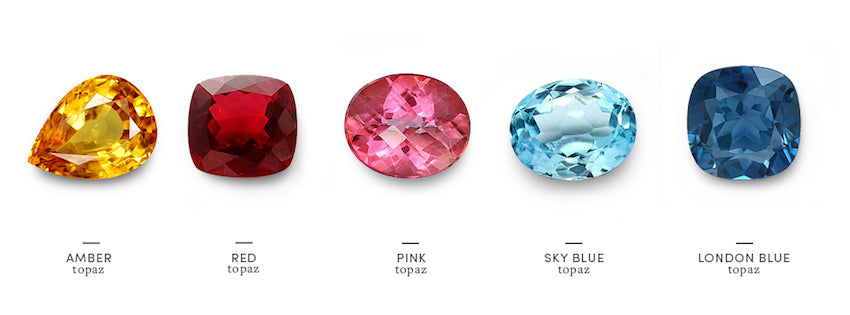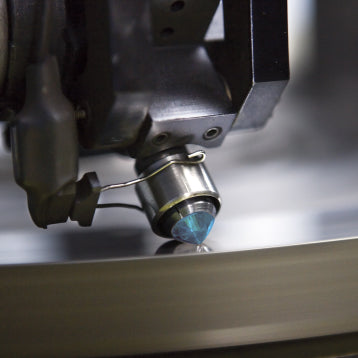Natural Topaz versus Lab Topaz
TABLE OF CONTENTS
Is There a Difference?
There are many things that the general public does not know about topaz gemstones. For starters, when it was first discovered, it was thought to be a diamond. Sounds odd for a gemstone that we think of as being yellowish in color, right?
Well, we wanted to discuss topaz, and some of the most relevant information related to this gemstone. Some of it may come as a complete surprise, but hopefully, all of it will be helpful and educational.
What is Natural Topaz?
People typically think of a traditional topaz as having an amber or yellow/orange color. That is not entirely wrong; topaz, like many other gemstones, can come in an assortment of colors. However, as with many gemstones (save for those, like sapphires or rubies), natural topaz is actually more commonly found as colorless, or nearly colorless, gemstone clusters. Also, not every orangish or honey-colored stone is actually a topaz.
What we once considered to be a “traditional” natural topaz is now sometimes referred to as a “precious” topaz. And other gemstones can also become colored with yellowish or brownish hues during the formation process, depending on any gasses or other elements that come into contact with them. Basically, natural topaz is a gemstone that looks a great deal like a diamond, and is just as beautiful and strong, but is much more common, and is often less expensive to purchase.

What is Lab Created Topaz?
Lab Topaz Formation
All gemstones undergo the same process to be created in labs. A “seed” of the gemstone, that was pulled from nature in much the same way that the gemstones themselves are mined, is put in a controlled environment that perfectly mimics the development and formation process that the gemstones undergo in nature. Gemstone experts carefully monitor the “growth” of these gemstone seeds, which occurs at a faster rate than it would in nature (the only difference between natural and lab monitored processes).
Topaz is no different in that regard. However, it is much less commonly done for topaz. They occur so frequently in nature that there is little need to create them in labs.
Major Differences Between Natural Topaz and Lab Topaz
The natural topaz gemstone is most often untreated. It usually goes on the market with its original color, clarity, etc. However, on occasion, labs will treat natural topaz gemstones, to intensify the color and other properties of the stone. But for the most part, the natural topaz you get is basically exactly as it was when it was mined, just cut and polished to maximize its appearance.
Lab created topaz is both grown and treated in a lab. This means that a seed of the gemstone is taken to grow a larger gemstone, mimicking the process of growth within the earth. Since many of the topaz created in labs start as colorless gemstones, specialists must treat the gems with their specific heat processes.
These processes enhance the overall visual appeal of the gemstone, and it is used to create, intensify or alter the topaz's colors. For people who value color, cut and/or clarity, specifically, above all else in their topaz stone, lab treated gemstones, such as heat treated topaz, are definitely for you.
Is a Lab Topaz Different from a Heat-Treated Topaz?
Lab gems are always grown and treated in the lab, whereas heat-treated gems are mined in the earth and then treated within a lab to improve clarity, color, and look. Both produce stunning jewelry quality gemstones. Heat treatments are permanent and are always safe when enhancing the look of the jewelry.
However, that heating process can be tweaked, depending on the color of topaz the specialists are trying to make, the intensity of the color, etc. Also, the naturally mined topaz stones usually undergo a slightly different heat process than those grown in labs. So, not every topaz stone will necessarily receive the exact same kind of heat treatment, but they all undergo some sort of similar process.

What About the Price Difference?
The price of topaz varies, depending on properties and qualities like color and clarity. This is true whether the gemstone is naturally mined, or lab created. The scale by which the value of topaz is estimated is sliding and can also depend a great deal on where you get your gemstone, in which type of jewelry, and the carat size of the stone.
However, generally, the value of a topaz depends a great deal on its color. For example, the colorless ones are the most common, and usually cost much less than other colors. The rarest topaz colors, such as red and pink, will cost more, whether they are natural, or lab created.
With Clarity Topaz
At With Clarity we carry a variety of gemstones that are graded in the AAA grade bracket. This ensures that the gemstone is at the highest quality.
Our London Blue Topaz ring catalog has a price range that appeals to many budgets and styles. One can create a beautiful blue gemstone ring up to 3.05 carats. And can set their beautiful gemstone in 14k white, rose, or yellow gold. London Blue With Clarity engagement rings range in price from $400 to $2,000, depending on the carat and shape, as well as the setting.
FAQs
What color is aquamarine?
What does an aquamarine do?
What is aquamarine good for?
Where can natural aquamarine be found?
How different does a natural vs. lab created aquamarine look?









